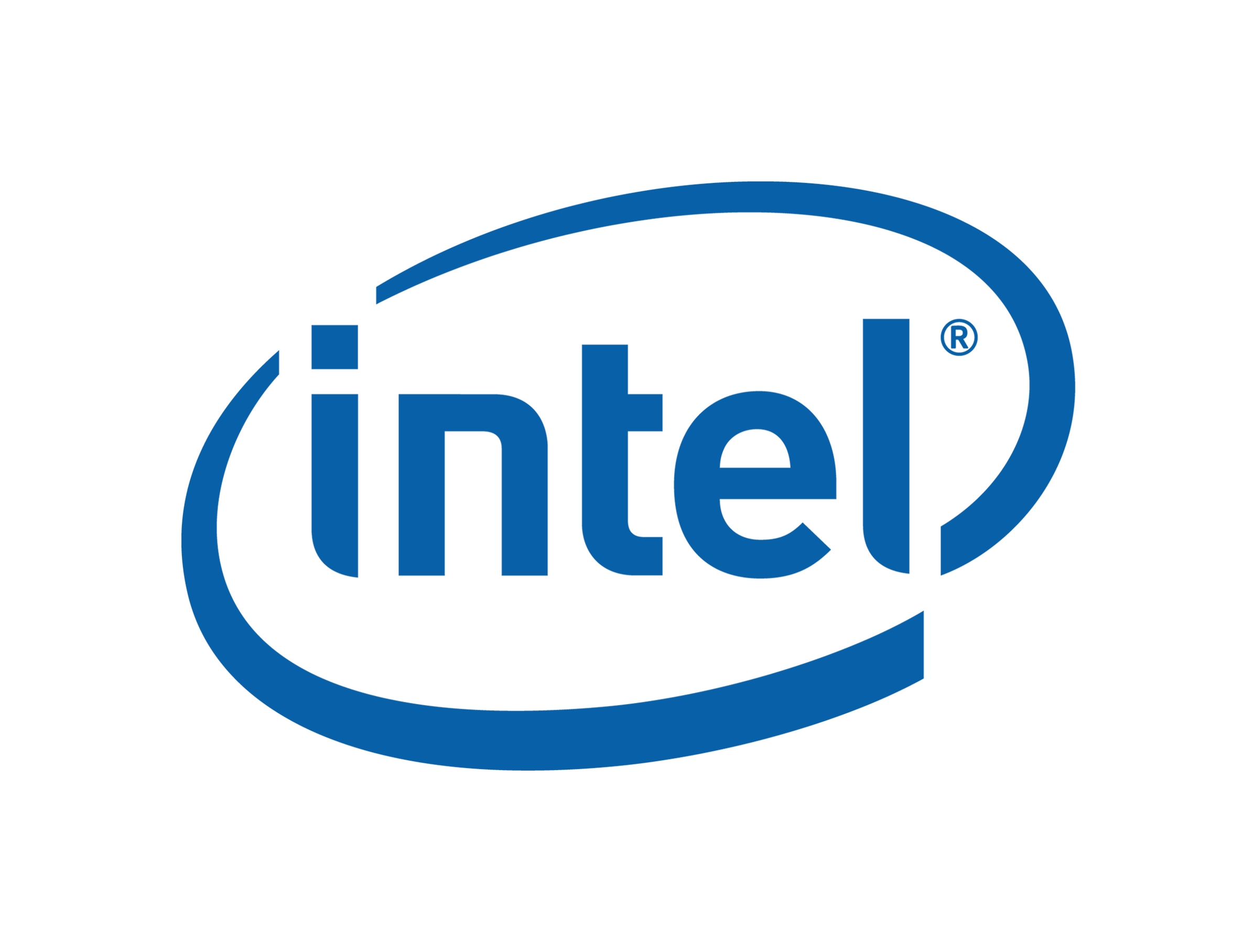Real World -
LightWave 3D 9.6 x64 -
Our first real world test is LightWave 3D. This is an industry standard 3D Animation and rendering software from Newtek. Our rendering tests with LightWave 9.6 have changed. I have always been a fan of the Classic Camera and the multi-pass PLD anti-aliasing that it offered. However, what I did not know was that this type of camera model was only capable of about 75-80% CPU utilization. This makes it very inefficient (as I am sure you guessed) so we made the shift to the newer perspective camera and are using its much better (100% CPU utilization) threaded engine as well as a newer and more efficient form of anti-aliasing. Along with this new camera model we get ray tracing and some other nice features. We have also leapt from the 1080p resolutions we used before and are now setup with a 35mm 4k resolution of 4096 x 3072; this should give the CPU a nice workout. To show off the vast difference in performance between the two we ran both and show you the render times here. This also shows what you can do when your application is truly written for a multi-threaded CPU.
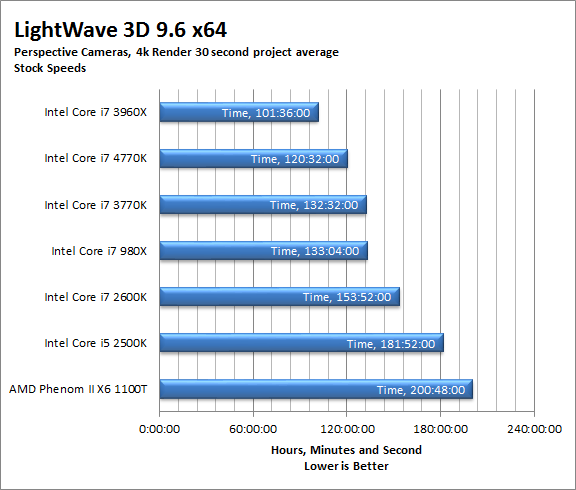
The AVX2 and multimedia improvements that Intel stuffed into the 4770k show their usefulness in our LightWave testing. With a healthy 41 second lead in our single 4k render test you can see that you are going to get a nice boost in your productivity. That 41 seconds translates to roughly 12 minutes over a 30 second project.
As you might imagine when we overclocked the 4770k things picked up even more.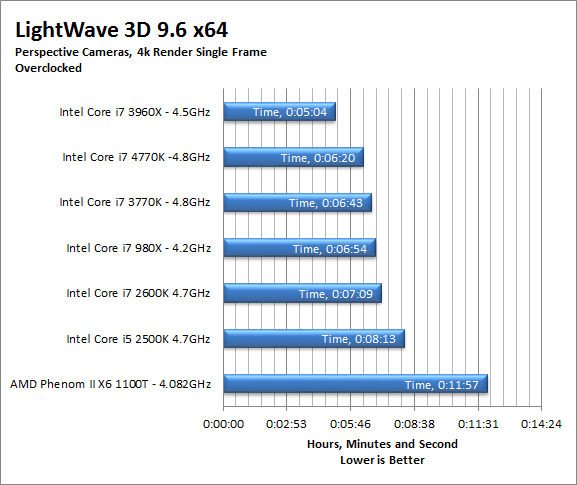
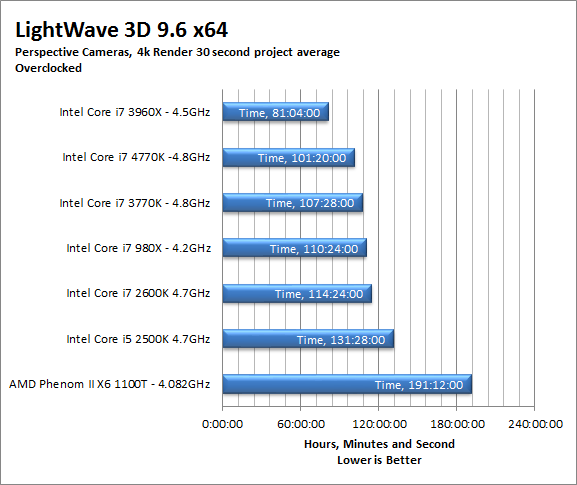
CyberLink Media Espresso 6.5 -
After having various issues with AutoGK and Intel CPUs with more than four cores we have changed our Media Encoding test to use Media Espresso from CyberLink. Although this new utility does not have the same ability to transfer directly from DVD it is still a good test to transfer different media types into a usable format for your iPad, iPod, or other media player. Our test involves using multiple (Six) 20 minute media files and transcoding them for an iPad. This gives us a very good indication of how well a motherboard can handle this type of work load.
Although we had to run a few updates to Media Espresso we did find that the new 4770k is more than capable of performing transcoding with speeds that are almost half what we saw with the 3770k.

After Effects CS6 -
Adobe’s After Effects CS6 is an application that can be used to add animation, text and other enhancements to your video productions. This powerful application is built to work with the available memory and can easily saturate even the largest of systems. Because of its multi-threaded design and the fact that it can break out existing system memory into per-thread (or per core) allocations it makes it a great test of a CPU especially one with a built in memory controller. Our test package was put together by Peter Kapas from Bjorn3d specifically to test multi-core/thread systems. The results are the time it takes the system to render the “Mountain Dew” test file.
The 4770k performs well with our Mountain Dew test, and comes in right around the same time as the 3770k The 2 second difference (0.2%) shown here is well inside the average margin of error for this test. When we overclock the 4770k it pulls way ahead of the others an almost 3 minute lead over the others.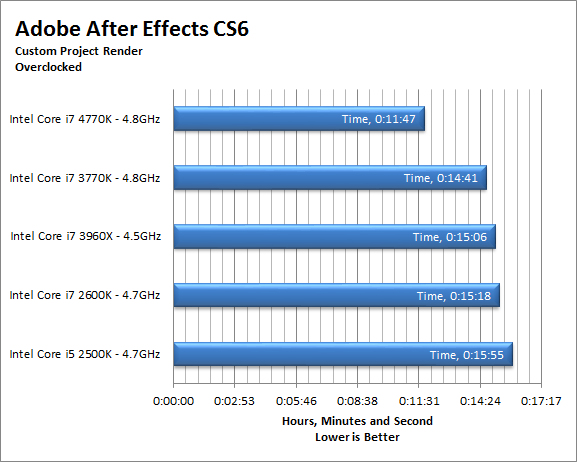
Adobe Premiere Pro CS6 -
Premiere Pro CS6 from Adobe is a non-linear video editing and rendering application. It has components that allow you take your raw footage and turn it into a full blown video production complete with professional style transitions, audio and video effects and more. You can use Premiere Pro to combine or overlay multiple video and audio streams in the same user interface. Our testing here is with two AVHDC streams that were shot using our Canon Vixia XA10. The original resolution is full 1080p and we render it as shown below. To add some additional work to the normal load we added in five transitions (fold-up, push, slide, cube spin, fade to white) along with an audio exponential fade at the beginning and end. We also added in an extra layer that was reduced in size to fit in a picture-in-picture format (in the upper left hand corner.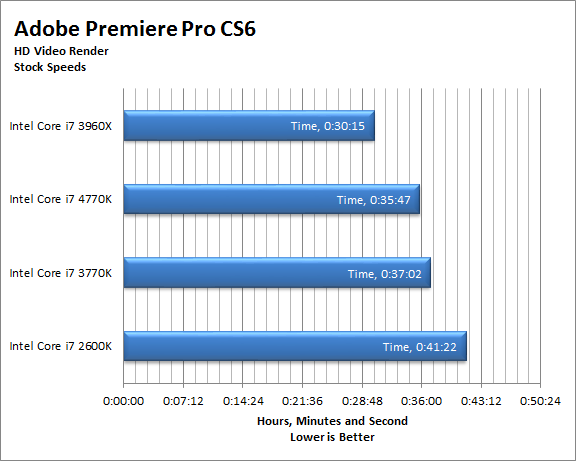
Oddly enough we see some unusual times here. The 4770k at stock speeds manages our tests quite well and comes in right under the Core i7 3960X (more cores four channels of RAM). The problem comes when we overclock the 4770k. Here we see it drop back to the bottom of the group which is unusual. We ran this test more than our usual three to confirm this and received similar results.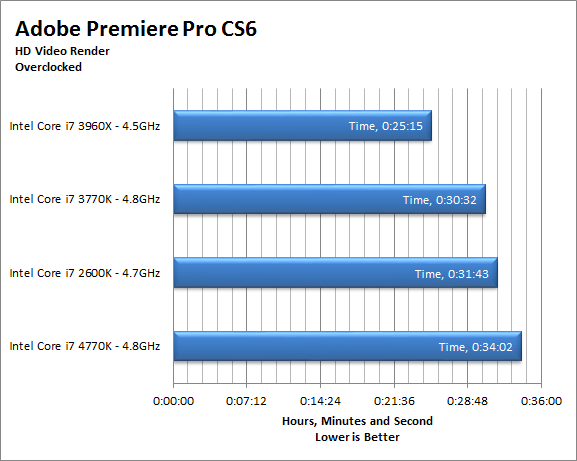
Adobe Light room 2.7 x64 -
Lightroom is a photo post-production software and while it cannot replace Photoshop in terms of editing or creating images, it has many features that are excellent in their own right. One of the ones that we find the more interesting (and beneficial to us) is the use of batch exporting for RAW camera files. This one feature can make it much easier to transfer the RAW images we shoot on our Canon Digital Rebel T1i all using the same settings (color profile, black level etc). For our testing we take 100 RAW files (around 1.7GB) and convert them to 75% quality JPEGs at 1536x1024 resolution (72 dpi). We add some metadata to identify the images and export them to a sub folder in the same original folder. We time this to see how well the CPU performs its duty. The results are shown below.
Looks like things are picking up on batch conversions. We are expecting to see this time push under one minute very soon as CPUs and software improve in the near future. The 4770k certainly stand out here quite nicely.


